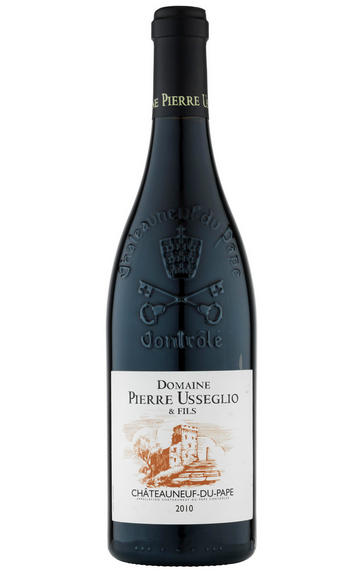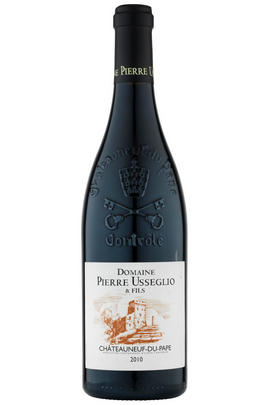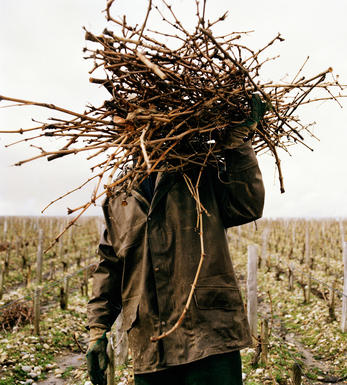
2010 Châteauneuf-du-Pape, Domaine Pierre Usseglio & Fils, Rhône

Critics reviews
Yields of the 2010 Tradition were only 23 hectoliters per hectare, which is almost financial suicide, but that’s Mother Nature. This is a dense wine exhibiting loads of black raspberry, blueberry, and blacker fruits than the 2009, with admirable purity, good acidity, and sweet tannin in a full-bodied, endearing style. This wine should drink well for 10-15 years.
(Robert Parker - Wine Advocate #197 Oct 2011)
Yields of the 2010 Tradition were only 23 hectoliters per hectare, which is almost financial suicide, but that’s Mother Nature. This is a dense wine exhibiting loads of black raspberry, blueberry, and blacker fruits than the 2009, with admirable purity, good acidity, and sweet tannin in a full-bodied, endearing style. This wine should drink well for 10-15 years.
(Robert Parker - Wine Advocate #197 Oct 2011)
About this WINE

Domaine Pierre Usseglio
This first class domaine is now run by Pierre Usseglio's sons Jean-Pierre and Thierry. It has recently expanded with the purchase of seven hectares of vines that Jean-Pierre had previously worked en metayage. The vineyards are split into three separate plots of vineyards in the La Crau, Serres and Le Bedine subzones of Châteauneuf-du-Pape. The vineyards are old with an average age of 80 years and are planted with Grenache Blanc, Clairette, Bourboulenc and Roussanne.
The grapes from each of the three parcels are fermented separately in concrete cuves before being blended and then and aged for between 18-24 months in immaculately kept oak foudres.

Châteauneuf-du-Pape
The most celebrated village of the Southern Rhône, Châteauneuf-du-Pape is the birthplace of the now indispensable French Appellation d’Origine Contrôlée system – imperfect though it may be. Compared to the Northern Rhône, the vineyards here are relatively flat and often feature the iconic galet pebbles – the precise benefits of which are a source of much debate. Minimum alcohol levels required by the AOC are the highest in France, but at 12.5% it is well below the natural generosity of Grenache, which only achieves its full aromatic potential when it is fully ripe and laden with the resultant high sugars. Syrah and Mourvèdre contribute the other defining elements in the blend, adding pepper, savoury spice and structure to the decadent Grenache. There are a further 10 permitted red grape varieties which can be used to adjust the “seasoning”. Of the five white varieties permitted, it is Grenache Noir’s sibling – predictably perhaps – Grenache Blanc, which dominates, though Roussanne shows a great deal of promise when handled well, notably at Château de Beaucastel.

Southern Rhône Blend
The vast majority of wines from the Southern Rhône are blends. There are 5 main black varieties, although others are used and the most famous wine of the region, Châteauneuf du Pape, can be made from as many as 13 different varieties. Grenache is the most important grape in the southern Rhône - it contributes alcohol, warmth and gentle juicy fruit and is an ideal base wine in the blend. Plantings of Syrah in the southern Rhône have risen dramatically in the last decade and it is an increasingly important component in blends. It rarely attains the heights that it does in the North but adds colour, backbone, tannins and soft ripe fruit to the blend.
The much-maligned Carignan has been on the retreat recently but is still included in many blends - the best old vines can add colour, body and spicy fruits. Cinsault is also backtracking but, if yields are restricted, can produce moderately well-coloured wines adding pleasant-light fruit to red and rosé blends. Finally, Mourvèdre, a grape from Bandol on the Mediterranean coast, has recently become an increasingly significant component of Southern Rhône blends - it often struggles to ripen fully but can add acidity, ripe spicy berry fruits and hints of tobacco to blends.


Buying options
Add to wishlist
Description
Chateauneuf du Pape Tradition is a blend of 80 % Grenache, 10% Syrah, 5% Cinsault og 5% Mourvèdre. The wine is matured in barriques (new or used for 12 months).
The Domaine was established by the Italian-born Francis Usseglio who emigrated in Chateauneuf du Pape in the early 1930s. Pierre Usseglio, the first son, took over the family vineyards, while the other son, Raymond, established his own estate. Today the 3rd generation Jean-Pierre and Thierry Usseglio are in charge of the Domaine.
wine at a glance
Delivery and quality guarantee